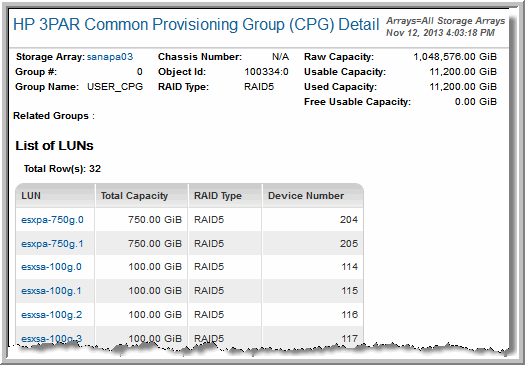
CPG Name | Name assigned to the Common Provisioning Group (CPG). Links to the
HP 3PAR Common Provisioning Group (CPG) Detail report. |
Storage Array | The name of the storage array. |
Allocated | Sum of the allocated size for all associated logical drives. |
User | Sum of the space allocated for users on all associated logical drives. |
Snap | Sum of the snap size for all associated logical drives. |
Admin | Sum of the admin size for all associated logical drives. |
Logical Drives | Number of allocated logical drives. |
Allocation Warning | User-defined threshold that can be set for Thinly Provisioned Virtual Volumes (TPVVs) and Commonly Provisioned Virtual Volumes (CPVVs) to alert users when they reach a certain size. |
Growth Incr | Unit of storage by which additional logical disks are created and allocated to a Common Provisioning Group (CPG). |
Growth Warning | User-defined threshold that can be set for Common Provisioning Groups (CPGs) to alert users when they reach a certain size. Growth warning is defined as: Growth Limit - (Allocation Warning * TotalManagedSpace)/100. |
Growth Limit | User-defined threshold that can be set for Common Provisioning Groups (CPGs) to cap their potential size. |
% Allocated | Calculated as Allocated/Growth Limit. |
Device Type (Speed) | Indicates the specified device type for physical disks: FC for Fibre Channel, NL for Nearline, and SSD for Solid State Drive. Indicates a rough performance estimation between the drive and the other drives in the system. This does not represent a rotational speed for the drives without spinning media (SSD). For FC and NL drives, the number corresponds to both a performance measurement and an actual rotational speed. For SSD drives, the number is a relative performance benchmark that takes into account in I/O per second, bandwidth and the access time. |
RAID Type | Indicates the RAID type for the logical disk: r0 = RAID-0, r1 = RAID-1, r5 = RAID-5 and r6 = RAID-6. RAID10 is displayed as RAID1+0. |
Set Size | Displays the set size in the number of chunklets. The default relies on the RAID type specified: 2 for RAID-1, 4 for RAID-5, and 8 for RAID-6. |
Availability | Normal or degraded |
Step Size | Value derived directly from the Virtual Volume (VV) or from the Common Provisioning Group (for Thinly Provisioned VVs and Commonly provisioned VVs). |
Row Size | Indicates the number of sets in a row. If the field is blank, no row limit is imposed. |
Disk Filter | Displays the specific logical disks for the Common Provisioning Group (CPG). |

Storage Array | The name of the storage array. Links to the
Array Capacity & Utilization (HP 3PAR View) report. |
Group # | The number of the Array Group. |
Group Name | The array group name. |
Chassis Number | The chassis to which the group belongs. |
Object ID | The object ID, for object-based storage. |
RAID Type | Indicates the RAID type for the logical disk. |
Raw Capacity | Total capacity for this array group. |
Usable Capacity | Total storage capacity of the group. |
Used Capacity | Amount of space that has already been used. |
Free Usable Capacity | Available storage. |